I'm trying to write a simple Arkanoid with the help of Python and Tkinter. The goal is to make the ball reflect from the top, right and left sides. And if the player misses the ball so it touches the bottom side, the game would stop.
Here's the code:
from Tkinter import *
import time
root = Tk()
canv = Canvas(root, highlightthickness=0)
canv.pack(fill='both', expand=True)
top = canv.create_line(0, 0, 640, 0, fill='green', tags=('top'))
left = canv.create_line(0, 0, 0, 480, fill='green', tags=('left'))
right = canv.create_line(639, 0, 639, 480, fill='green', tags=('right'))
bottom = canv.create_line(0, 478, 640, 478, fill='red', tags=('bottom'))
rect = canv.create_rectangle(270, 468, 365, 478, outline='black', fill='gray40', tags=('rect'))
ball = canv.create_oval(0, 20, 20, 40, outline='black', fill='gray40', tags=('ball'))
delta_x = delta_y = 3
new_x, new_y = delta_x, -delta_y
while True:
time.sleep(0.025)
if canv.find_overlapping(canv.coords(ball)[0], canv.coords(ball)[1], canv.coords(ball)[2], canv.coords(ball)[3])[0] == 1:
new_x, new_y = delta_x, -delta_y
canv.move(ball, new_x, new_y)
print 'fitst if', new_x, new_y
if canv.find_overlapping(canv.coords(ball)[0], canv.coords(ball)[1], canv.coords(ball)[2], canv.coords(ball)[3])[0] == 2:
new_x, new_y = delta_x, delta_y
canv.move(ball, new_x, new_y)
print '2nd if', new_x, new_y
if canv.find_overlapping(canv.coords(ball)[0], canv.coords(ball)[1], canv.coords(ball)[2], canv.coords(ball)[3])[0] == 3:
new_x, new_y = -delta_x, delta_y
canv.move(ball, new_x, new_y)
if canv.find_overlapping(canv.coords(ball)[0], canv.coords(ball)[1], canv.coords(ball)[2], canv.coords(ball)[3])[0] == 4:
new_x, new_y = delta_x, -delta_y
canv.move(ball, new_x, new_y)
print new_x, new_y
canv.move(ball, new_y, new_y)
canv.update()
def move_right(event):
canv.move(rect, 7, 0)
pass
def move_left(event):
canv.move(rect, -7, 0)
pass
root.bind('<Right>', move_right)
root.bind('<Left>', move_left)
root.geometry('%sx%s+%s+%s' %(640, 480, 100, 100))
root.resizable(0, 0)
root.mainloop()
Why the ball reflecting in the wrong way?
